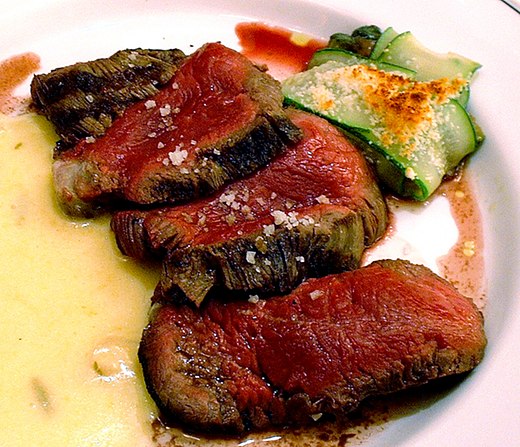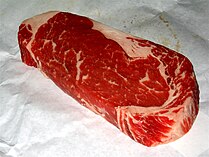
 Beef cuts | |
| Type | Tenderloin cut of beef |
|---|---|
Chateaubriand steak (also chateaubriand) is a meat dish cooked with a thick cut from the tenderloin filet. In contemporary times, chateaubriand cuts of beef refer to "a large steak cut from the thickest part of a fillet of beef". [1]

A dish in gastronomy is a specific food preparation, a "distinct article or variety of food," ready to eat, or be served.

A beef tenderloin, known as an eye fillet in Australasia, filet in France, and fillet in the United Kingdom and South Africa, is cut from the loin of beef.

Cuts of beef are first divided into primal cuts, pieces of meat initially separated from the carcass during butchering. These are basic sections from which steaks and other subdivisions are cut. The term "primal cut" is quite different from "prime cut", used to characterize cuts considered to be of higher quality. Since the animal's legs and neck muscles do the most work, they are the toughest; the meat becomes more tender as distance from hoof and horn increases. Different countries and cuisines have different cuts and names, and sometimes use the same name for a different cut; e.g., the cut described as "brisket" in the US is from a significantly different part of the carcass than British brisket. "Cut" often refers narrowly to skeletal muscle, but can also include other edible flesh, such as offal or bones without significant muscles attached.
Contents
In the gastronomy of the 19th century, the steak for chateaubriand was cut from the sirloin, [2] and the dish was served with a reduced sauce named chateaubriand sauce (or a similar sauce) that is prepared with white wine and shallots moistened with demi-glace, and mixed with butter, tarragon, and lemon juice. It was also traditionally served with mushrooms. [2] [3] [4]

Gastronomy is the study of the relationship between food and culture, the art of preparing and serving rich or delicate and appetizing food, the cooking styles of particular regions, and the science of good eating. One who is well versed in gastronomy is called a gastronome, while a gastronomist is one who unites theory and practice in the study of gastronomy. Practical gastronomy is associated with the practice and study of the preparation, production, and service of the various foods and beverages, from countries around the world. Theoretical gastronomy supports practical gastronomy. It is related with a system and process approach, focused on recipes, techniques and cookery books. Food gastronomy is connected with food and beverages and their genesis. Technical gastronomy underpins practical gastronomy, introducing a rigorous approach to evaluation of gastronomic topics.

In cooking, reduction is the process of thickening and intensifying the flavor of a liquid mixture such as a soup, sauce, wine, or juice by simmering or boiling.

In cooking, a sauce is a liquid, cream, or semi-solid food, served on or used in preparing other foods. Most sauces are not normally consumed by themselves; they add flavor, moisture, and visual appeal to a dish. Sauce is a French word taken from the Latin salsa, meaning salted. Possibly the oldest recorded European sauce is garum, the fish sauce used by the Ancient Greeks; while doubanjiang, the Chinese soy bean paste is mentioned in Rites of Zhou in the 3rd century BC.




















